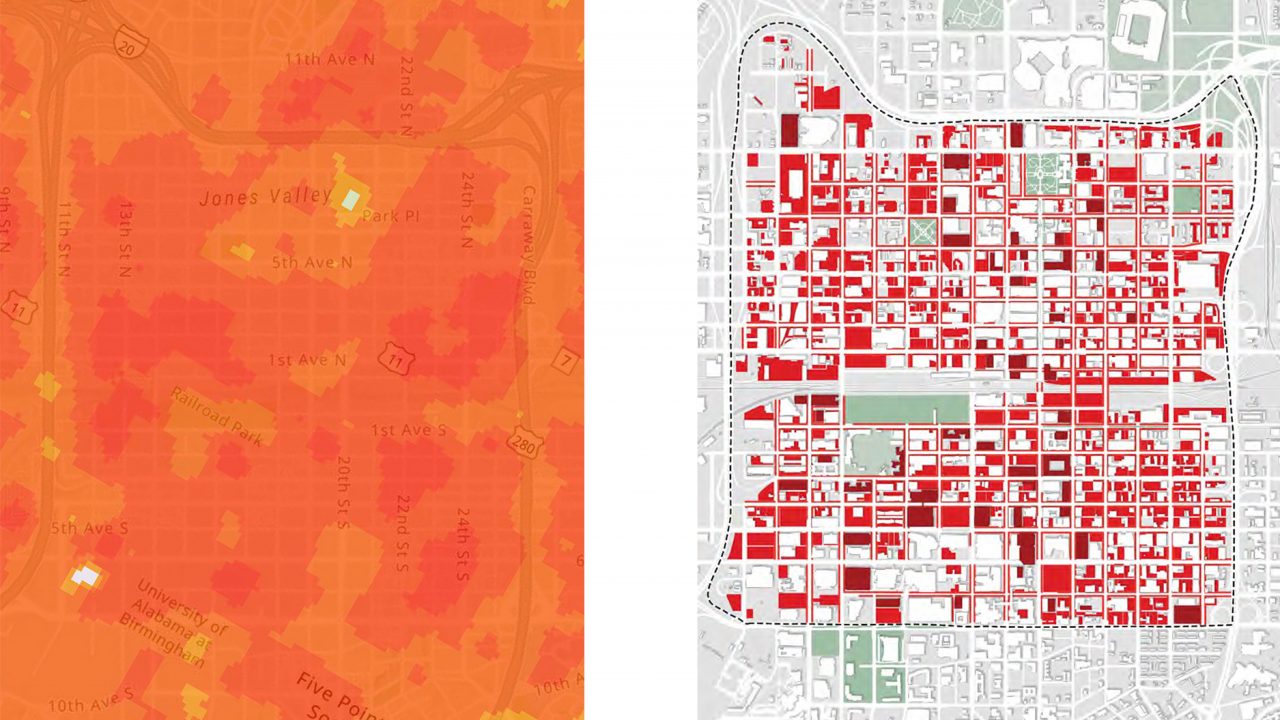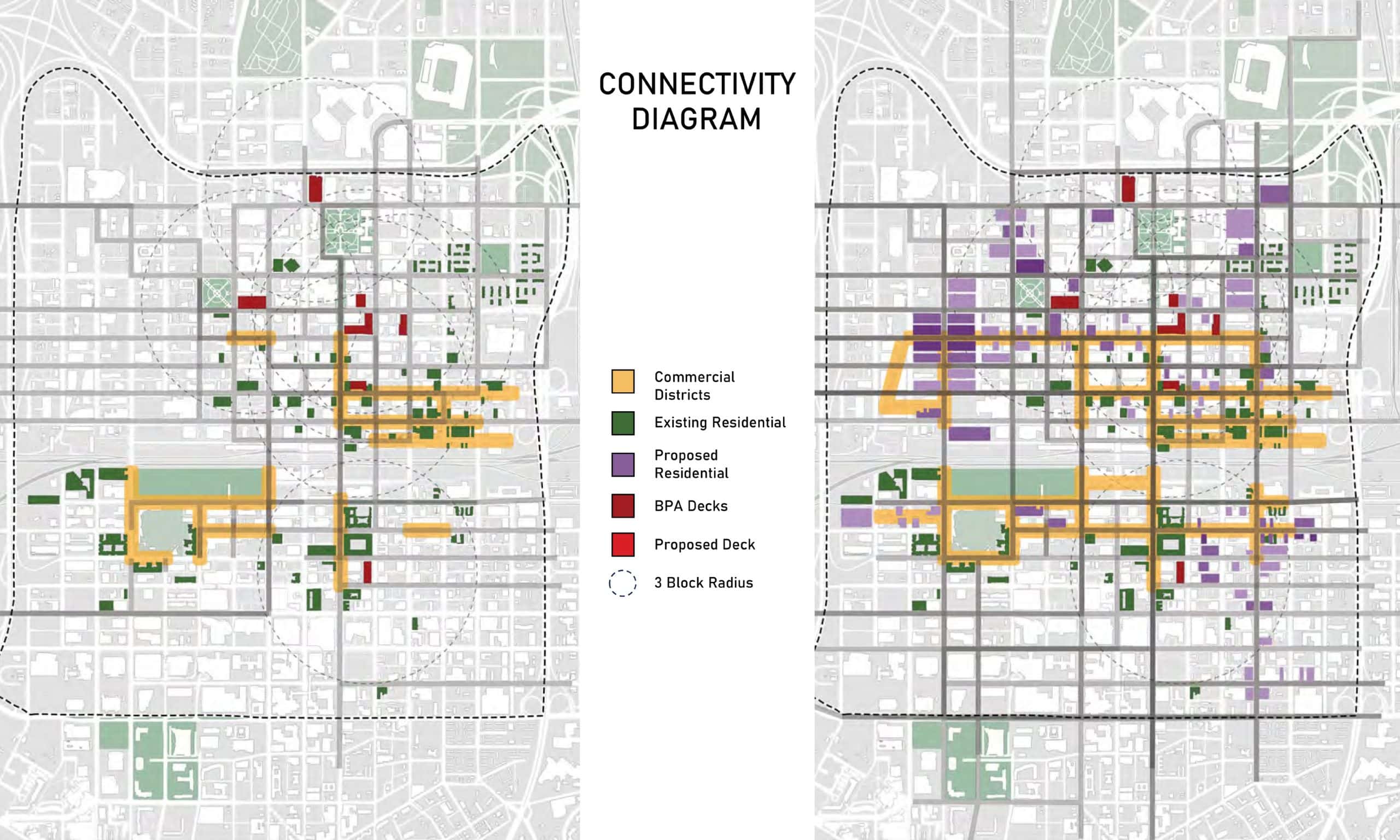Urban Studio Students Address Birmingham Parking

At Auburn University’s Urban Studio, students learn their craft and get hands-on experience in seeing and understanding the real-world problems architects and planners address—problems similar to those they will be addressing once they graduate.
“Ugh, I can’t find any parking!” There probably isn’t a driver anywhere in the world who hasn’t uttered this sentence at least once in their lifetime. When you are driving in a city like Birmingham, it often seems like you could put this sentence on repeat for every block you drive.
Is parking really as big of a problem as it feels? It seems like a huge problem for many motorists, especially when you have event tickets or dinner reservations.
This year, the 2023–24 fifth years at the Urban Studio tackled Birmingham’s “parking problem.” Their “Birmingham Parking Study” presentation was a comprehensive look at parking in Birmingham’s downtown area and focused on the current and future state of parking as part of the city’s master plan. They worked with their professors and the city’s planning department to understand the current parking situation and the plans for parking in the future.
Their study began with the goals of the Birmingham City Center Master Plan, which include increasing and concentrating city density, improving streets for aesthetics and pedestrian use, increasing diverse housing options, managing commuter traffic while maintaining a walkable city and better utilizing parking resources through management and regulation.
 What is the parking reality in Birmingham? It’s actually better than people think. The students assessed the current parking infrastructure and examined parking decks, street parking and surface lot parking. Their study highlighted specific data on the usage and capacity of various Birmingham Parking Authority (BPA) decks, especially the underutilization of existing spaces.
What is the parking reality in Birmingham? It’s actually better than people think. The students assessed the current parking infrastructure and examined parking decks, street parking and surface lot parking. Their study highlighted specific data on the usage and capacity of various Birmingham Parking Authority (BPA) decks, especially the underutilization of existing spaces.
Yes, the students discovered a high level of underutilized parking in downtown Birmingham. Despite the general public’s perception of a parking problem in Birmingham, the data proves differently. The students conducted an assessment of the usage of different parking decks at specific times, providing insights into parking patterns and utilization rates. One of the most interesting findings of their study was with the spaces in city-owned parking decks where, on an average Wednesday in September, by mid-morning only 50% of the available parking spaces were in use.

It could be argued that the spaces are empty because no one wants to pay to park. Street parking in Birmingham is free after 5:00 p.m. and on the weekends, which are usually everyone’s first options. There are paid lots as well as paid decks throughout the city (both privately and publicly owned). One thing the students extrapolated from their study: suburban parking in both lots and decks is often plentiful and free, which likely contributes to the misperception of the lack of “available” (read “free”) parking downtown.
However, free parking is never truly free. Their study also provided a cost analysis of parking space construction, comparing surface lot spaces with above-grade and below-grade garage spaces. It also outlined the total cost implications under current and proposed parking codes. From adding parking costs into commercial and residential rent to construction costs in building and maintaining decks and lots, much of the “free” parking motorists take for granted still costs somebody something and usually trickles down to consumers.
Those costs aren’t limited to cash, though. Creating and constructing parking opportunities comes with environmental impacts. During the study, the students expanded their understanding of urban heat islands and how materials affect the environment. A majority of parking lots and decks are constructed with impervious materials.
Have you ever wondered why it seems hotter downtown than when you get home to the suburbs? Buildings, and especially traditional parking lots and decks, are built without environmentally friendly drainage options, often causing runoff that has nowhere to go and leads to flooding instead of feeding an environment that mitigates heat production. When impervious materials are used to surface a parking lot, there are little to no landscaping options to help the area cool off nor are there trees to provide shade. Additionally, the rainwater does not replenish the groundwater supplies, leading to concerns like low water reservoir levels.

The study projects an urban population growth over the next 10 years, detailing an increase in housing units, office space and hotel rooms. The students compared current and proposed parking codes, showing potential changes in parking space requirements for different types of buildings and units. More people coming downtown means more cars downtown. To attract people not just to work but to live downtown, parking will be a crucial aspect of any plans for city improvements.
For this assignment, the students did more than collect data and study the situation; they are proposing solutions. They emphasized the importance of a “Complete Streets” approach in making Birmingham a more connected and inclusive city. Students outlined the current conditions of commercial districts, bus and shuttle routes, bike lanes and walkable streets to propose changes that would enhance connectivity in the community.
“Complete Streets” is an urban design approach focused on creating street layouts that are safe, convenient and accessible for all users, regardless of their mode of transportation, age or ability and includes:
- Safety for All Users
- Accessibility
- Multimodal Transportation
- Public Spaces
- Economic and Environmental Benefits
- Integrated Urban Planning
- Flexibility

Implementing Complete Streets might involve adding bike lanes, improving sidewalks, installing traffic calming measures, ensuring accessible public transportation stops and creating more green spaces. The goal is to create a balanced, integrated transportation system that supports all community members’ health, safety and welfare.
The students were asked how they thought Birmingham was doing in implementing a Complete Streets approach. From what they learned, the group agreed that Birmingham is working on it and making improvements, but there’s still work to be done. As long as the city continues with its incremental changes, citizens will continue to see improvement towards a more accessible city, which will then attract more people and businesses downtown and contribute to the vibrancy and liveliness of the city. However, if the slow pace continues, it could take 20-30 years to experience the benefits.
What’s next for the students? Aspects of the parking study are being turned into thesis projects for the Fifth Years:
Jeremy Daniel is focusing on Historic Smithfield. The area has an abundance of small sites, often 20’ x 140’, and one of the biggest challenges for new, multi-family housing on small lots is how the need for housing and the legal requirements for parking are often at odds.
Camille Lewellyn is tackling the environmental impact of architecture. Her topic is on regenerative architecture and how it combats urban heat islands.
Jack McMullen is analyzing how downtown Birmingham does not have enough family-oriented neighborhoods. The lack of pedestrian-friendly spaces, safe and accessible outdoor space and school access affects how Birmingham will be able to attract families from suburban areas.
Jimmy Ramsey is examining the “placeless intersection” at Second Avenue South and 23rd Street. He’ll propose options for transforming and reshaping the site from its current lackluster state to something that contributes to Birmingham’s sense of place.
Adrian Steward is studying the potential for new residential developments on the west side of Birmingham, how they will affect parking and the lack of parking options in the area. Through the lens of parking deck construction, he is looking at how people emotionally and psychologically relate to architecture.
The impact of learning at the Urban Studio goes well beyond taking students out of the theoretical and into real projects that have the potential to solve real problems. By working on projects like the Birmingham parking study, students are exposed to the ways architecture affects people. It gets them out of the “architect vacuum” so they can see and experience what happens before and after the architect becomes involved and how the architect fits into a bigger process. Their “laboratory” is a real, living city with a past, a present and a future. Urban Studio projects make them step back, look at the urban condition and try to answer the why.
For many people, architecture is the only art form they will interact with on a daily basis. You may not see a Picasso or a Van Gogh every day, but you will have to deal with some form of the built environment. The Urban Studio experience gives students the opportunity to understand how architecture is more than a structure—there are emotional, historical, sociological, political, environmental, psychological, economic and artistic implications for real people.
Want to learn more about the Urban Studio experience?
See more in:
Student Experience,
Student Work,
Urban Studio
Related people:
Alex Krumdieck,
Jennifer Cloe